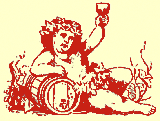|
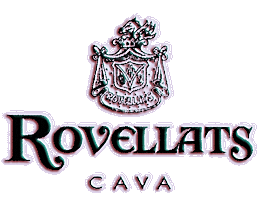 María
Rosa Cardona is the queenpin of Cava Rovellats, the renowned Spanish
winery in Catalonia, an hour east of Barcelona. María
Rosa Cardona is the queenpin of Cava Rovellats, the renowned Spanish
winery in Catalonia, an hour east of Barcelona.
A lawyer and photographer, she’s the blonde sparkplug of the
210-hectare estate in Penedès established in 1303 that makes
sparkling wine from highly coddled grapes.
Her wines are carefully aged six years on the lees (the spent yeasts)
after the second fermentation in the bottle, a technique shared with
Champagne icons Krug and Roederer to produce complex, elegant bubblies,
at a fraction of the French price!
Today, Rovellats also makes whites and red table wines from Spanish and
French grapes. The native Parellada, Xarel-lo and Macabeo are
judiciously blended with a little Chardonnay.
The red Monastrell and Tempranillo grapes combine to make the delicious
Rosé Brut and Bru de Tardor ‘02 is Cabernet Sauvignon, Merlot
and Garnacha, aged in French oak and very nicely New World in style.
Blanc de Primavera is Parellada, Xarel-lo and Chardonnay without oak,
round and aromatic, great with cream-sauced dishes, mild cheeses and
poultry.
The 100% Chardonnay, also unoaked, is elegantly fruity with a spicy Mediterranean flair.
Rovellats, in small production but of superior quality, sells mainly
through Spain's finest restaurants. Little of the wine leaves Spain but
Piatto chef and wine importer Fernando García of Spain Only 1
brings some here (call 416 888 7253)
Whites: Chardonnay ‘04, $19.90, Blanc de Primavera ‘04 $15.50.
Cavas: Rosé Brut $24, Chardonnay Brut Nature $28, Imperial Brut
$34.15, Masía S.XV Brut Nature (6 years on the lees) $34.15,
Gran Reserva Brut Nature $29.00, Brut Reserva $23.50, Magnum Brut
Nature $55.
Red: Bru de Tardor ‘03 $28.05
* Meanwhile, in other Spanish news, global warming is starting to harm
vineyards in southern Spain and forcing growers to consider moving to
the cool Pyrenees. Winemakers are already shading their vines,
developing heat-resistant strains and relocating to the mountains.
Temperatures may rise 7C by 2099, says José Manuel Moreno at the
University of Castilla La Mancha. Spain’s average summer high is 29C.
Winemakers must plan ahead because vines produce for 80 years and are
exposed to generations of warming temperatures, says Richard Smart, the
respected Aussie consultant who advises on climate change.
Spain is the closest major producer to the equator, and particularly
vulnerable to climate changes. One degree of climate change makes
wine-growing regions similar to regions 200 km further south, says
Bernard Séguin of France's National Institute for Agronomic
Research.
Regulators should allow winemakers to irrigate, says Spain’s Federation
of Winemaking Associations, which is developing heat-resistant grapes
in greenhouses.
Wine character is on the verge of radical change, experts are warning.
Computer models show that within 50 years Bordeaux and Napa will rise
by 1.2C, Barolo 1.4C, Rioja 1.3C, Portugal 2C.
Other regions are already near top of the range and drought is a
growing problem. These areas include Penedès and La Mancha in
Spain, Chianti and southern Italy, southern France, the Hunter Valley
in Australia, parts of Chile and the Central Valley of California.
Temperatures in New Zealand, southern Australia, parts of Chile and
South Africa will rise more slowly thanks to more water and less land
mass.
Some reds may lose color, some will lose varietal flavor, and some
whites may disappear, says Richard Smart. “The effect will be profound.”
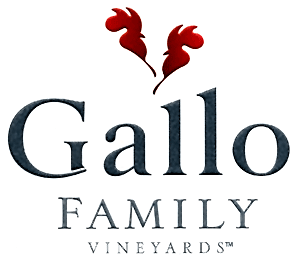 The
world’s best known brand is changing its name! Gallo of Sonoma, the
largest family wine company, is becoming Gallo Family Vineyards. The
world’s best known brand is changing its name! Gallo of Sonoma, the
largest family wine company, is becoming Gallo Family Vineyards.
The aim is to bring consistency to a multitude of labels and highlight the Modesto-based E&J Gallo's family ownership.
"We really want to create a global brand of Gallo Family Vineyards on
which to unify all these brands," says Stephanie Gallo, marketing
director and granddaughter of Ernest, who founded the firm with the
late Julio in 1933.
The new label combines Gallo of Sonoma, retailing for between US$12-$15
and Gallo’s Twin Valley wines from the Central Valley retailing for
US$5. The grape sources and winemaking remain separate.
The company saw its Twin Valley customers trading up to the Sonoma
wines and felt a common marketing theme would encourage this trend,
Gallo says.
"We're not abandoning Sonoma," says Stephanie. "It's Gallo Family
Vineyards Sonoma Reserve." The line includes single vineyard wines at
US$20-$35 a bottle, and estate wines at US$50-$75.
Gallo is one of the largest vineyard owners in Sonoma County, with
3,100 acres in production. About 500,000 of the 2 million cases
produced at the Dry Creek Valley winery are Gallo of Sonoma, and Gallo
also makes Rancho Zabaco and Frei Brothers there.
Gallo brands such as Louis M. Martini and Napa Valley Vineyards are
unaffected. Last year, Gallo won approval to expand the Healdsburg
winery to produce 4.9 million cases which would make it the largest in
Sonoma County.
Gallo began buying vineyards in Sonoma County in 1971 with the Frei
Brothers’ ranch in the Dry Creek Valley. It launched the Gallo of
Sonoma brand in 1994 with great fanfare.
The transition to Gallo Family Vineyards should be complete by the company's 75th anniversary in 2008.
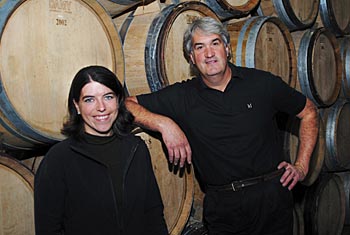 In
a metaphor for the perversity of wine growing, the heavens chose
exactly the wrong day to open, the opening of a grand new Niagara
winery. In
a metaphor for the perversity of wine growing, the heavens chose
exactly the wrong day to open, the opening of a grand new Niagara
winery.
Helicopters were grounded, buses assembled, Plan B implemented – and
wine scribes bused through the deluge to experience the dazzling Le
Clos Jordanne.
The wines are stunning, a testimony to vision, skill, and deep pockets,
the love child of Vincor and Boisset, now adopted by new Vincor owner
Constellation Brands, biggest wine company on the planet.
Truly Burgundy grown in Ontario, the Pinot Noir and Chardonnay wines
from four vineyards at the village of Jordan put Canadian wines in the
global Big Leagues.
The concept dates back to then-CEO Don Triggs and Jean-Charles Boisset
hitting it off over dinner and saying ”What if we did something
together in Canada....” The inspiration was Alliance, a collaboration
of Inniskillin and Jaffelin, now part of Boisset.
J-C felt a frisson as he walked over the Jordan Bench with its
limestone, clay, silt terroir because it “looks so much like the hills
above Corton and Clos Vougeot.” Translation: bankable in Burgundy
terms.
Journo-turned-winemaker Thomas Bachelder and fellow Quebec winemaker
Isabelle Meunier were hired. The vines were shipped from Burgundy and
planted in 2000.
Nine ‘04s are available in three tiers, and three ‘03s (the first
vintage) will soon be in selected restaurants. Le Grand Clos Pinot Noir
‘04 and Chardonnay ‘04 are $60 and $55 respectively. The
single-vineyard Pinots and Chardonnays from Le Clos Jordanne, Claystone
Terrace and La Petite Vineyard are $35. The Village Reserve wines are
$25.
Vincor President Jay Wright, flanked by Rob Sands of Constellation,
explained that Jordanne’s 130 acres “enjoy similar soil and climate to
the Côte d’Or. High-density planting provides the high
concentration of the wines, whose every stage is carried out gently by
hand, organically, and by gravity. Ecocert Canada certificate received
in 2005.
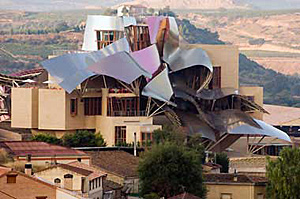 The
crown jewel, down the road, will be a futuristic Frank Gehry-designed
winery with white walls, glass and a “silver cloud” of titanium for the
roof. Gehry designed the new winery of Marqués de Riscal in the
Rioja village of Elciego. The roof is inspired by the swirling costumes
of Flamenco dancers. The
crown jewel, down the road, will be a futuristic Frank Gehry-designed
winery with white walls, glass and a “silver cloud” of titanium for the
roof. Gehry designed the new winery of Marqués de Riscal in the
Rioja village of Elciego. The roof is inspired by the swirling costumes
of Flamenco dancers.
There may be a European wine lake, but there’s one in Australia, too.
Wine in the supermarkets is cheaper than water as a huge Oz glut drives
it below $2 a bottle. Huge harvests for three years have led to a
massive oversupply, with a billion litres unsold, in tanks across the
country. The average price for exports is only $3.78 a litre.
Meanwhile, world prices have tumbled 8% in the year to August. There’s
a massive shakeout in the wind.
Winemakers have seen equity and profits tumble and many growers are
being forced out of business. For consumers, it means wines at a
fraction of the normal price as producers unload stock in generically
labeled bottles known as cleanskins. Export prices have dropped a third
since 2002 and two in five wineries are making losses.
Massive vine plantings have been undertaken since the launch of
Australia 2020, a visionary plan to put Oz wine in the forefront of
world wine production. As a result, for most of the nineties, wine
exports grew at 17% every year, an unbelievable surge. Oz is now the
world’s number four exporter behind France, Italy and Spain.
In the year ending in June, Ontarians drank 14 million litres of
Oz-wine, red and white, a 25% increase, a rate maintained for five
years across Canada (31 million bottles a year, one per Canadian!).
The great Aussie strength is the freedom to blend grape varieties
across huge regions, creating consistent and powerful brands. There are
a few fruit-bearing vines going back to the 1850s and the industry
dates back to 1788 plantings around Sydney.
Even though prices are falling, Australia has displaced France in
volume as the favorite import of the bellwether British market (with
California now in third spot and Italy fourth, followed by S. Africa,
Spain, Chile, Germany, Argentina and New Zealand. )
Meanwhile, Australia has dropped the terms Sherry and Port on its
labels in an effort to gain better access to European. The designation
Port becomes Australian Tawny and Vintage Port becomes Australian
Vintage.
In Europe, consumption has fallen 11% in 20 years and demand for New
World wines is growing. The EU is considering eliminating 400,000 of
its 3.4 million hectares of vineyards.
Per capita consumption in France, Italy and Spain is decreasing, but
the British can't get enough: Brits drank 23 litres of wine each last
year, nearly six more than in 2000. The 10 most popular brands in
Britain now come from Australia and the US, with easily remembered
names (Jacob's Creek, Blossom Hill) and informative labeling.
Even the English wine industry is stealing a march on the French. Many
UK producers have switched to sparkling varieties, with impressive
results. About 350 vineyards, the industry has enjoyed double-digit
annual growth in the last five years.
Please take me back to
the top of the page!
Please take me back to
Being There!
|
|
|

